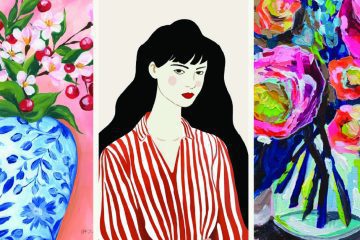Abstract art and surface pattern design have always been exciting areas for artists and designers to express creativity. Unlike realistic art, abstract work plays with colors, shapes, and forms without strict rules, inviting both the artist and the viewer to interpret freely. Surface pattern design takes this a step further by applying these artistic elements to objects like fabrics, wallpapers, and everyday items, blending art with functionality.
Now, with AI, abstract art and pattern design are reaching new levels. Artists can try out endless ideas, mixing creativity with technology in ways never seen before. AI makes the design process faster, helping artists experiment and improve their work more easily.
Find out AI is changing the game and what it means for artists and designers.
How AI can Help with Creation of Abstract Art?
The rise of AI is taking Abstract Art and Surface Pattern Design to exciting new heights, blending innovation with creativity. AI is like having a creative assistant who works tirelessly in the background. It helps artists by generating ideas, suggesting color schemes, and even creating full-fledged pieces that can be used or modified. This doesn’t mean AI replaces the artist—it’s more like adding a powerful tool to their creative toolbox.
One way AI aids abstract artists is by creating unique compositions quickly. For example, AI programs like DeepArt or Runway ML can take an input (such as a sketch or an idea) and develop complex abstract designs that would take hours, or even days, to complete manually. These AI tools use algorithms that learn from existing artwork and can make suggestions or generate new works in the style chosen by the artist.
How AI and Surface Pattern Design Works
Surface pattern design involves creating repeating patterns for things like fabric, wallpaper, or packaging. This design process often requires precision and creativity. AI can make this job easier and more efficient in several ways:
1.Custom Elements: AI can generate custom elements that might not exist in stock image libraries. For example, if an artist wants a unique brushstroke or abstract shape, AI can create these in seconds, providing endless possibilities for pattern design.
2.Pattern Generation: AI can create seamless, repeating patterns with just a few inputs. Instead of manually repeating a pattern and ensuring all parts align perfectly, artists can use AI tools to automate this step. This is particularly useful for designers who need to produce patterns at scale without sacrificing quality.
3.Color Matching and Suggestions: One of the trickiest parts of design is choosing the right colors. AI can analyze current trends, suggest complementary colors, and even match colors to evoke specific emotions. Programs like Adobe Sensei use AI to help artists pick palettes that work well together, speeding up the decision-making process.
Abstract Art and Surface Pattern Design allow artists to explore creativity through bold colors, shapes, and unique designs, and AI makes it even easier by generating fresh ideas and patterns in no time.
Benefits of Using AI in Art and Design
With Abstract Art and Surface Pattern Design, everyday items like fabrics and wallpapers become works of art. AI brings many advantages to abstract artists and pattern designers. It comes with many benefits and can improve your efficiency in multiple ways.
Here are some of the top benefits:
- Speed and Efficiency: An artist can create drafts quickly, experiment with different styles, and find the perfect look faster than ever.
- Endless Creativity: AI tools can create countless variations of a pattern or abstract piece. This gives the artist more options to choose from and more inspiration for their work.
- Better Workflow: AI tools can handle repetitive and technical tasks, such as creating seamless patterns or adjusting colors. This frees up the artist to focus on the creative and expressive parts of the work.
Tips for Using AI in Your Art Practice
- Start Simple: Try free or easy-to-use AI tools like Canva to see how they work. Their AI features are great for beginners.
- Add Your Touch: Make AI designs your own by adding hand-drawn details or changing parts to match your style.
- Mix It Up: Combine AI designs with traditional or digital art to create unique and layered pieces.
- Stay in the Loop: Keep up with new AI tools and updates to stay inspired and ahead of the game.
In Conclusion
AI is transforming the way abstract art and surface pattern design are created. It’s not here to replace artists but to make the creative process faster, more efficient, and more inspiring. By embracing this technology, artists can expand their skills and produce innovative work that bridges the gap between traditional and digital art. The future of art and design is full of possibilities, and AI is just one part of this exciting journey.
What do you think about using AI for abstract art and surface pattern design? Let us know in the comments.
FAQs
- What’s the difference between abstract art and traditional art?
Abstract art focuses on colors, shapes, and forms without showing real objects, while traditional art tries to show scenes or subjects we recognize.
- Can AI create original artwork by itself?
AI can make designs based on patterns, but it still needs human input to add creativity and make the artwork unique.
- How can AI help artists in design?
AI can suggest new patterns, speed up tasks, and provide tools for trying out new ideas, so artists can focus on improving their work.
- Is AI replacing human artists in abstract art and pattern design?
No, AI is just a tool that helps artists. Humans are still needed to add creativity and give a personal touch to the final design.
- What are some examples of products that use surface pattern design?
Surface pattern designs are used on things like clothing, home decor, stationery, packaging, and even on digital products like websites and apps.



0 Comments